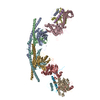+検索条件
-Structure paper
| タイトル | Structural Basis of BRCC36 Function in DNA Repair and Immune Regulation. |
|---|---|
| ジャーナル・号・ページ | Mol Cell, Vol. 75, Issue 3, Page 483-497.e9, Year 2019 |
| 掲載日 | 2019年8月8日 |
 著者 著者 | Julius Rabl / Richard D Bunker / Andreas D Schenk / Simone Cavadini / Mark E Gill / Wassim Abdulrahman / Amparo Andrés-Pons / Martijn S Luijsterburg / Adel F M Ibrahim / Emma Branigan / Jacob D Aguirre / Aimee H Marceau / Claire Guérillon / Tewis Bouwmeester / Ulrich Hassiepen / Antoine H F M Peters / Martin Renatus / Laurent Gelman / Seth M Rubin / Niels Mailand / Haico van Attikum / Ronald T Hay / Nicolas H Thomä /      |
| PubMed 要旨 | In mammals, ∼100 deubiquitinases act on ∼20,000 intracellular ubiquitination sites. Deubiquitinases are commonly regarded as constitutively active, with limited regulatory and targeting capacity. ...In mammals, ∼100 deubiquitinases act on ∼20,000 intracellular ubiquitination sites. Deubiquitinases are commonly regarded as constitutively active, with limited regulatory and targeting capacity. The BRCA1-A and BRISC complexes serve in DNA double-strand break repair and immune signaling and contain the lysine-63 linkage-specific BRCC36 subunit that is functionalized by scaffold subunits ABRAXAS and ABRO1, respectively. The molecular basis underlying BRCA1-A and BRISC function is currently unknown. Here we show that in the BRCA1-A complex structure, ABRAXAS integrates the DNA repair protein RAP80 and provides a high-affinity binding site that sequesters the tumor suppressor BRCA1 away from the break site. In the BRISC structure, ABRO1 binds SHMT2α, a metabolic enzyme enabling cancer growth in hypoxic environments, which we find prevents BRCC36 from binding and cleaving ubiquitin chains. Our work explains modularity in the BRCC36 DUB family, with different adaptor subunits conferring diversified targeting and regulatory functions. |
 リンク リンク |  Mol Cell / Mol Cell /  PubMed:31253574 / PubMed:31253574 /  PubMed Central PubMed Central |
| 手法 | EM (単粒子) / X線回折 |
| 解像度 | 3.75 - 3.9 Å |
| 構造データ |  PDB-6gvw: |
| 化合物 |  ChemComp-ZN:  ChemComp-HOH: |
| 由来 |
|
 キーワード キーワード | SIGNALING PROTEIN / Deubiquitinase complex / DUB / Lysine-63 linkage specific / BRCC36-containing / BRCA1A binding |
 ムービー
ムービー コントローラー
コントローラー 構造ビューア
構造ビューア 万見文献について
万見文献について





 homo sapiens (ヒト)
homo sapiens (ヒト)
